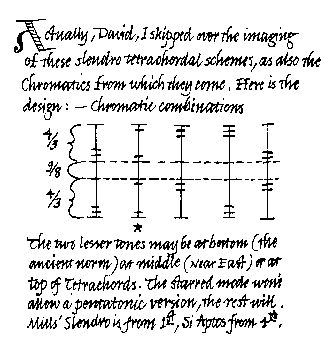DD—For instance, in your own compositions, when you choose a tuning for a particular piece, is it on the basis that the particular tuning you're choosing is going to evoke some particular mood. Or are you choosing the tuning and letting it set the mood?
LH—Actually, you're right about that. I tend to choose because I know it's evocative, but I’m not exactly certain of what. Yes. you're right; when I compose. I choose certain complexes because experience with those has taught me that they do evoke certain emotional feelings. Well. emotions are "ex-motions;" that is, they're "out-of-movement." They're what you don't dance! it's like gesturing; that's motion.
How can I put this? Certain interval combinations I can make to seem to have certain expressive characteristics. For example. I have always fundamentally felt that a funeral march is not really satisfactory in a brilliant C-major. I don't know why; because, of course, there is a Handel one that is. Chromaticism, for example, tends to me to be emotionally tense and expressive; it can also be tender. Whereas diatonicism tends to be more open. Here again. I have the same feelings. fundamentally. about pelog and slendro. I think of pelog as largely chromatic, though I know damned well that pelog barang [2, 3, 5, 6, 7] is a wide-open major and sounds so—that's one of the reasons it’s liked so much. But still. I think of it as having a bit of interior tension and introspection.
…And I’ve always maintained that, if you're a Western composer—if you come from a Northwest-Asian background—you ought to be able to compose both diatonically and chromatically. That, think, is a given. I never understood the schizophrenia that used to happen in the '40s—you were either a chromatic composer or a neoclassicist—and it seems to me that any proper Northwest-Asian composer should do both. That's part of the tradition of being a composer, to be able to deal with chromatics as well as diatonics. And what does that mean? The Greeks, for example. There is historical evidence that for quite a long period they were absolutely mad for the chromatic tetrachord, which has two “halfish” steps and a minor third. And there are hundreds of them. And you could do that either in pentatonic or in heptatonic method. If you use heptatonic method, it sounds like prototypical blues music. Within the heptatonic, you've got two prototypical pentatonics. If you want to use those, you've got the one with the half step and wide third, or the one with the larger slendro style intervals. I think of those things when I’m choosing a mode.

Only recently, for example, in this new quintet I’ve written, I decided to explore a mode which is a chromatic, with two tetrachords in which the half steps (I’m using rough terminology) cluster at the top and the bottom of the tetrachords. Instead of duplicating one another regularly they mirror one another, as it were. That was grand fun. And I made it in the form of a dance. To me it has a kind of evocative—it's a kind of dance that is not—dear me, you see my attribution system doesn’t work very well, does it? I think of it as, well for example, I can only do it by negatives: it's not a harvest dance, it's not a landler, that sort of thing—it's a more sensuous kind of dance, because of those half steps. And that was fun. That was a direct exploration of those two tetrachords—I don't think I’ve ever heard a piece written in that mode, and I wanted to hear it, so that's why I did it. In the finale of my organ concerto [Concerto for Organ with Percussion Orchestra, Crystal Records S858], I did another chromatic in which the half steps are in the top of each tetrachord. Most people think it's a jazz celebration—when I wrote it, I thought of it as being directly derived from Cesar Franck's symphony finale, there again a question of attribution. Then there's that business of using music for therapeutic purposes, much of which nowadays—you find a record to meditate by or something—what it means is secondary sevenths in general slosh. [Laughter] I could no more meditate to it than fly. So again, attributions are funny. Thinking about that, I was thinking about the project I entertainingly thought up because a friend of mine was scandalized because some of his music was used in an erotic movie. I almost said, "Oh, just shut up and ask for credit." But then I thought, well, when I next have a leisure moment, I’ll write a whole suite of pieces; "Music for an Erotic Film." For example: "Music to Blank By," "Music to Blank By," …then it occurred to me, how am I going to make these attributions? What intervals, what rhythms, and so on... it's a real problem. So I guess I’m sort of a song and dance man in the abstract.
But I do like exploring different modes, and as I say, there's no lack of them. I haven't run out yet. and I don't think I’m going to very soon.
DD—No. It seems like anyone with a computer or a calculator, or a pencil and a piece of paper, can turn them out endlessly. It's finding out what to do with them that takes the time.
LH—Well yes, but that's the fun of it too, making it real. I was just thinking, also, of the therapeutic business. Did the Greeks really suggest that you play the Dorian over the affected portions in the temple of Askleplos for half an hour? Would that have constituted a legitimate treatment? I will go so far as to say this: I have thought that rational tuning generally does improve one's mind and assemble one's spirit. I do believe that. Whereas I think the general disorder of an equal temperament of any kind is not good for us.